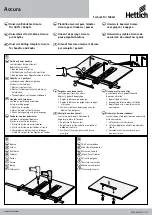
9 - English
OPERATION
NOTE:
A reference depth scale is located on the motor
housing which can be used to measure depth of cut.
Each mark on the scale indicates a 1/16 in. change in
depth setting. Use the top edge of the removable base
as reference when setting depth of cut.
WARNING:
Avoid open area of router base. Serious personal
injury will result from contact with a rotating bit.
USING EDGE GUIDE
See Figures 12 - 13, page 13.
Use the edge guide to trim or cut a straight or curved edge.
Remove the battery pack.
Thread guide bars into the base and tighten with a flat
head screwdriver.
Slide the edge guide onto the guide bars.
Install thumb screws provided into the edge guide.
Measure the proper distance to offset the bit, or if trim-
ming, position the bit at the edge of the workpiece.
Tighten the two thumb screws to secure the edge guide.
Reinstall the battery pack.
Move the router along the workpiece keeping the edge
guide in constant contact with edge of the workpiece.
ATTACHING THE ROUND SUBBASE
See Figure 14, page 13.
Remove the battery pack.
Turn the router upside down to remove the four subbase
screws and the square subbase.
Attach the round subbase using the same screws.
Tighten the screws securely. Do not over tighten.
WARNING:
Always use the base for laminate trimming. Use
of the router without a base or using the incorrect
base can result in serious personal injury.
MAINTENANCE
WARNING:
When servicing, use only identical replacement
parts. Use of any other part could create a hazard
or cause product damage.
WARNING:
Always wear eye protection with side shields
marked to comply with ANSI Z87.1. Failure to do
so could result in objects being thrown into your
eyes and other possible serious injuries.
WARNING:
To avoid serious personal injury, always remove
the battery pack from the tool when cleaning,
performing any maintenance, or when storing the
tool.
GENERAL MAINTENANCE
Avoid using solvents when cleaning plastic parts. Most
plastics are susceptible to damage from various types of
commercial solvents and can be damaged by their use. Use
clean cloths to remove dirt, dust, oil, grease, etc.
WARNING:
Do not at any time let brake fluids, gasoline,
petroleum-based products, penetrating oils, etc.,
come in contact with plastic parts. Chemicals can
damage, weaken or destroy plastic which could
result in serious personal injury.










































